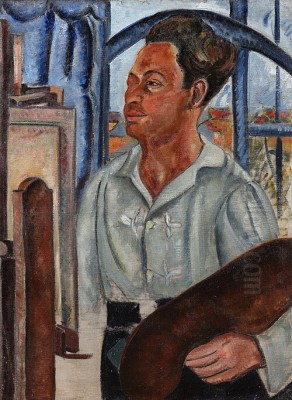
André Favory stands as a significant, though perhaps sometimes overlooked, figure in the vibrant landscape of early twentieth-century French art. A painter dedicated primarily to the human form, particularly the female nude, Favory navigated the turbulent currents of modernism, absorbing influences from Fauvism and Cubism before forging a distinctive style characterized by sensuous forms, rich colour, and a robust sense of volume. His work embodies a fascinating dialogue between avant-garde experimentation and a renewed appreciation for structure and tradition that emerged in the years following the First World War.
French Roots and Artistic Beginnings
Born in Paris in 1888, André Favory came of age during a period of immense artistic ferment. France, and Paris in particular, was the undisputed centre of the Western art world. Young artists were exposed to the legacy of Impressionism and Post-Impressionism, with the revolutionary works of painters like Claude Monet, Pierre-Auguste Renoir, and especially Paul Cézanne and Paul Gauguin, reshaping perceptions of colour, form, and the very purpose of painting.
Like many aspiring artists of his generation, Favory sought formal training to hone his craft. He enrolled at the Académie Julian, a renowned private art school in Paris that served as a crucial training ground for numerous French and international artists. The Académie offered a more liberal alternative to the official École des Beaux-Arts, fostering experimentation while still providing a solid grounding in drawing and painting techniques. It was here that Favory likely began to develop his technical skills and absorb the diverse influences circulating in the Parisian art scene.
Encounters with Modernism: Fauvism and Beyond
The early years of the 20th century were dominated by the explosive arrival of Fauvism. Led by figures such as Henri Matisse, André Derain, and Maurice de Vlaminck, the Fauves ("wild beasts") shocked the art establishment with their non-naturalistic, often strident use of colour and bold, simplified forms. Their exhibitions at the Salon d'Automne, starting in 1905, were pivotal events.
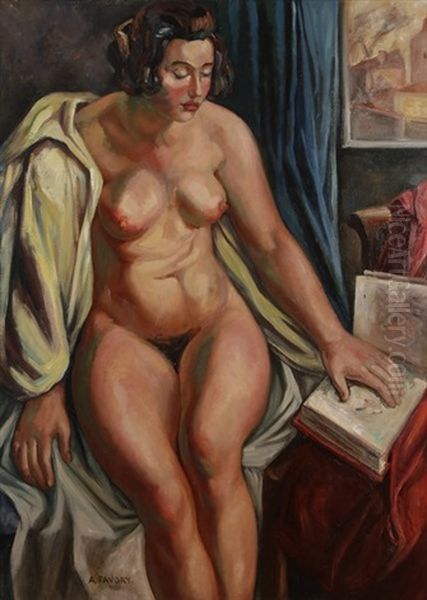
Favory, like many young painters, was inevitably impacted by this colour revolution. His works from the period around 1907 to the early 1910s show a clear engagement with Fauvist principles. He employed brighter palettes and a more expressive brushstroke, exploring the emotional and decorative potential of pure colour. While perhaps not a core member of the Fauvist group, this phase was crucial for liberating his approach to colour and composition.
Following Fauvism, the analytical and geometric explorations of Cubism, pioneered by Pablo Picasso and Georges Braque, presented another powerful challenge to traditional representation. While Favory does not appear to have fully embraced the fragmented perspectives of Cubism, the movement's emphasis on structure, volume, and the underlying geometry of forms likely resonated with him, particularly as he moved towards his mature style.
Forging a Personal Vision: The Return to Order
The First World War marked a profound rupture in European culture and society. In the art world, the pre-war avant-garde's relentless drive towards abstraction and deconstruction gave way, for many artists, to a desire for stability, clarity, and a reconnection with tradition. This widespread tendency became known as the "Return to Order" (Retour à l'ordre).
André Favory's art from the late 1910s and 1920s aligns strongly with this movement. He moved away from the high-keyed colours of his Fauvist phase towards a richer, more sonorous palette. His primary focus solidified around the human figure, especially the female nude, rendered with a new emphasis on volume, solidity, and sculptural presence. While informed by modernism, his work now sought a balance between expressive freedom and classical ideals of form and composition.
His brushwork remained vigorous and painterly, but it was employed to build substantial forms rather than dissolve them. There is a palpable sense of weight and physicality in his figures. This approach can be seen as drawing inspiration from the structural concerns of Paul Cézanne, whose influence became increasingly pervasive in this period, as well as potentially looking back to the robust sensuality of Baroque masters like Peter Paul Rubens, albeit translated into a modern idiom.
The Nude as a Central Theme
The female nude is the dominant subject throughout André Favory's mature work. He explored this theme with remarkable consistency, depicting women bathing, reclining, reading, or simply presented as powerful studies of form and flesh. His nudes are rarely idealized in a purely classical sense; instead, they possess a distinct earthiness and vitality. They are often full-bodied, celebrating a sensuous physicality.
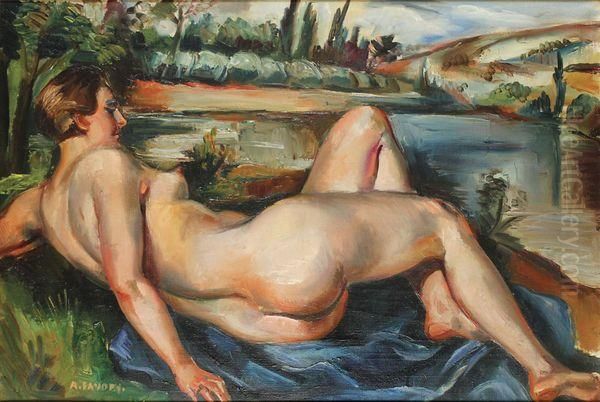
His representative work, Nude Bathing in a River, now housed in the Cheltenham Art Gallery & Museum in the UK, exemplifies many characteristics of his style. The painting (an oil on canvas measuring 64cm x 44.8cm) likely depicts one or more female figures in a landscape setting, rendered with Favory's typical attention to rounded volumes and rich, warm colours. The theme of bathers allowed him to combine the study of the figure with the depiction of nature, often resulting in compositions imbued with a sense of idyllic, almost timeless sensuality.
Other known titles further illustrate his dedication to this subject: Nu au livre (Nude with a Book), Baigneuses (Bathers), Femme de trois quarts (Woman in Three-Quarters View), and La Baigneuse (The Bather). These works showcase his ability to capture the weight, texture, and presence of the human body through bold modelling and a confident handling of paint. His approach was distinct from the linear elegance of Amedeo Modigliani or the sometimes unsettling intensity of Chaïm Soutine, fellow artists of the School of Paris who also frequently depicted the figure.
Exhibitions and the School of Paris
Favory actively participated in the Parisian art world, exhibiting his work regularly at the major independent Salons. These large, juried exhibitions were crucial venues for artists operating outside the official academic system. Records indicate his presence at the Salon d'Automne (from 1910 onwards), the Salon des Indépendants, and later, the Salon des Tuileries. Exhibiting alongside contemporaries provided visibility and placed his work within the ongoing dialogue of modern French painting.
He was part of the broader milieu known as the School of Paris (École de Paris), a term used to describe the diverse community of French and émigré artists who flocked to the city, particularly to the neighbourhoods of Montmartre and Montparnasse, during the first decades of the 20th century. This vibrant scene included artists with vastly different styles, such as Marc Chagall, Moïse Kisling, Jules Pascin, Raoul Dufy, and Othon Friesz, among many others.
While specific records of Favory's direct personal interactions or close friendships with many of these famous contemporaries are not readily available in public sources, his participation in the Salons and his stylistic concerns firmly place him within this dynamic context. His work, with its blend of modern sensibilities and a focus on traditional genres like the nude, contributed to the rich tapestry of artistic production during this era. He shared with artists like André Lhote an interest in reconciling modernism with a sense of order and structure.
Style and Technique
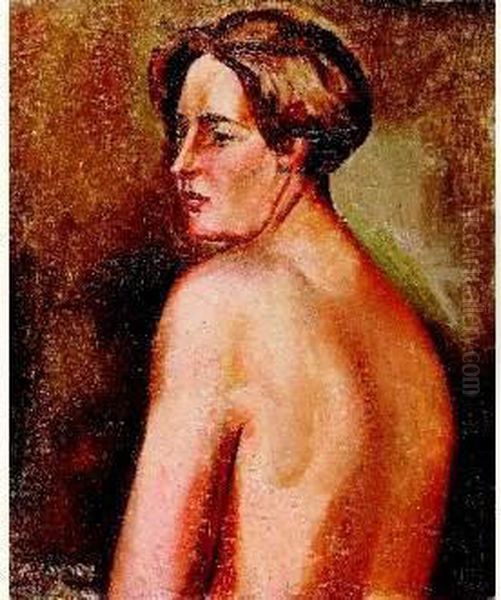
Favory's technique centred on oil painting, typically on canvas. His mature style is often described as having "delicate brushwork," yet this should be understood in the context of building substantial form rather than creating Impressionistic effects. The brushstrokes are visible and contribute to the texture and vitality of the surface, but they define volumes clearly. His "profound depiction of nude forms" points to his skill in rendering anatomy not just accurately, but with a sense of weight, warmth, and life.
The terms "decorative" and "expressive," mentioned in the initial source material, also apply. The decorative quality might relate to his rich colour harmonies and rhythmic compositions. The expressiveness comes through the vigour of the paint application and the inherent sensuality and presence of his figures. He achieved a balance where the act of painting – the colour, the texture, the stroke – is evident and enjoyable, while still serving the representation of his chosen subject matter.
His colour palette, while moving away from pure Fauvism, remained rich and often warm, favouring ochres, reds, warm greens, and deep blues to model form and create atmosphere. He wasn't afraid of strong contrasts but used them to enhance the feeling of volume and light, rather than for purely emotional shock value as some earlier Fauves had done.
Later Years and Legacy
André Favory continued to paint and exhibit throughout the 1920s and into the 1930s. His commitment to figurative painting remained steadfast, even as abstraction gained ground elsewhere. He maintained his focus on the nude, landscape, and occasionally still life, refining his robust, sensuous style.
His career was cut relatively short by his death in Paris in 1937, at the age of 49. This perhaps contributed to him being less widely known today than some contemporaries who had longer careers spanning the mid-20th century. However, during his active years, he achieved a notable level of recognition within the Parisian art scene.
His legacy lies in his contribution to the figurative tradition within French modernism. He represents a significant strand of the "Return to Order," demonstrating how artists could absorb the lessons of the pre-war avant-garde – particularly regarding colour and formal simplification – while reinvesting them into paintings that celebrated the human form and the tangible world with renewed vigour and sensuality. His work offers a compelling alternative to the paths of pure abstraction or Surrealism that dominated other sectors of the art world.
Collections and Market Presence
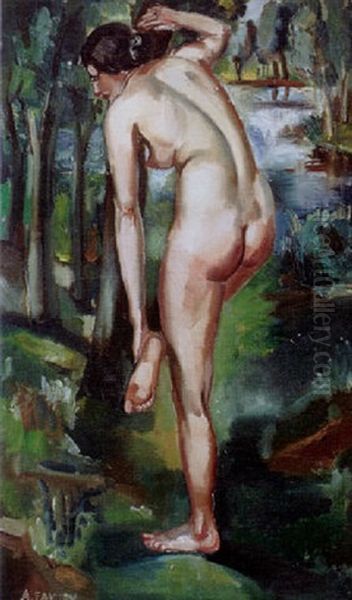
While Favory may not be a household name like Matisse or Picasso, his works are held in public and private collections. The specific mention of Nude Bathing in a River being in the Cheltenham Art Gallery & Museum provides a concrete example of his presence in a UK public institution.
As indicated by auction records, such as the mention of his work La Baigneuse appearing in a 2024 "ART IMPRESSIONNISTE & MODERNE" sale, his paintings continue to circulate on the art market. It is likely that many of his works remain in private hands, passed down through families or acquired by collectors specializing in the School of Paris or early 20th-century figurative art. The relative scarcity of information about widespread institutional holdings might suggest his market was primarily driven by private collectors and galleries during and after his lifetime.
Conclusion: A Painter of Sensuous Vitality
André Favory was a dedicated French painter whose artistic journey reflects the key transformations in European art during the early 20th century. He engaged with the colouristic freedom of Fauvism before developing a mature style rooted in the post-war "Return to Order." His enduring commitment to the human figure, particularly the female nude, resulted in a body of work characterized by robust forms, rich colour, vigorous brushwork, and a profound sense of sensuous vitality.
Though perhaps overshadowed by some of the towering figures of modern art, Favory carved out a distinct and valuable niche. His paintings celebrate the physicality of the human form and the pleasure of paint itself, offering a powerful affirmation of figurative art during a time of radical experimentation. As a significant artist of the School of Paris, his work merits continued attention for its skillful synthesis of modern influences and enduring artistic traditions, leaving behind compelling images of warmth, strength, and life.